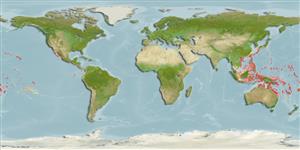>
Eupercaria/misc (Various families in series Eupercaria) >
Labridae (Wrasses) > Corinae
Etymology: Stethojulis: Greek, stetho, stethion = brest; literal = to prick a little breast + Greek, ioulis, a fish dealing with genera Coris or Thalassoma (Ref. 45335).
More on authors: Quoy & Gaimard.
Environment: milieu / climate zone / depth range / distribution range
Ecología
marino asociado a arrecife; rango de profundidad ? - 22 m (Ref. 86689). Tropical
Eastern Central Pacific: Hawaiian Islands and Johnston Island.
Tamaño / Peso / Age
Maturity: Lm ? range ? - ? cm
Max length : 15.0 cm TL macho / no sexado; (Ref. 86689)
Benthopelagic (Ref. 58302). Common in shallow water (maximum 22 m), over sand and lagal covered rocks; observed to take quick, seemingly indiscrimate bites of the substratum with sand emitted from its gills (Ref. 86689). Feeds primarily on bivalves, polychaete worms, peanut worms, gastropods, various small crustaceans and foraminiferans (Ref. 3921).
Life cycle and mating behavior
Madurez | Reproducción | Puesta | Huevos | Fecundidad | Larva
Oviparous, distinct pairing during breeding (Ref. 205).
Randall, J.E., 2007. Reef and shore fishes of the Hawaiian Islands. Sea Grant College Program, University of Hawai'i, Honolulu. i-xivb + 1-546. (Ref. 86689)
IUCN Red List Status (Ref. 130435: Version 2024-1)
Threat to humans
Harmless
Human uses
Pesquerías: comercial; Acuario: Comercial
Herramientas
Special reports
Download XML
Fuentes de Internet
Estimates based on models
Preferred temperature (Ref.
123201): 24.6 - 29.3, mean 28.3 °C (based on 1606 cells).
Phylogenetic diversity index (Ref.
82804): PD
50 = 0.5010 [Uniqueness, from 0.5 = low to 2.0 = high].
Bayesian length-weight: a=0.00977 (0.00438 - 0.02182), b=3.07 (2.90 - 3.24), in cm total length, based on LWR estimates for this Genus-body shape (Ref.
93245).
Nivel trófico (Ref.
69278): 3.5 ±0.3 se; based on diet studies.
Resiliencia (Ref.
120179): Alto, población duplicada en un tiempo mínimo inferior a 15 meses (Preliminary K or Fecundity.).
Fishing Vulnerability (Ref.
59153): Low vulnerability (10 of 100).
Nutrients (Ref.
124155): Calcium = 90.9 [54.2, 155.8] mg/100g; Iron = 0.73 [0.42, 1.36] mg/100g; Protein = 18.5 [15.7, 20.7] %; Omega3 = 0.147 [0.093, 0.234] g/100g; Selenium = 20.2 [11.8, 37.3] μg/100g; VitaminA = 148 [46, 547] μg/100g; Zinc = 1.75 [1.20, 2.77] mg/100g (wet weight);
